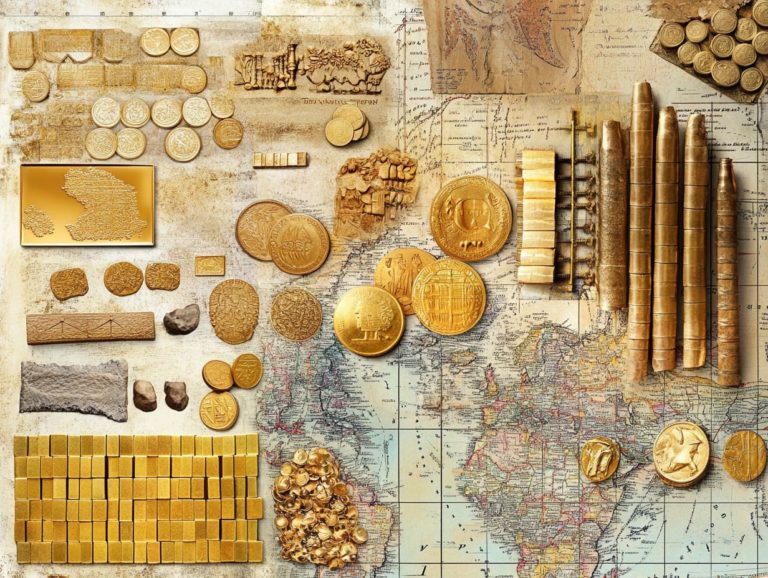How to Use Precious Metals in Estate Planning?
Estate planning is an essential process that allows you to manage and distribute your assets in accordance with your wishes.
One strategy gaining traction is the incorporation of precious metals like gold and silver into your estate plan. Let s explore the exciting reasons you should include precious metals in your estate plan!
This article delves into the compelling reasons to include these valuable assets, emphasizing their benefits for diversification and protection against inflation.
You’ll learn about the various types of precious metals worth considering, how to seamlessly integrate them into your estate plan, and important tax considerations along with potential challenges.
Discover how adding precious metals can elevate your estate planning strategy and safeguard your legacy for generations to come.
Contents
- Key Takeaways:
- Reasons to Include Precious Metals in Estate Planning
- Types of Precious Metals for Estate Planning
- How to Incorporate Precious Metals into Your Estate Plan
- Tax Considerations for Using Precious Metals in Estate Planning
- Potential Challenges and Solutions
- Frequently Asked Questions
- What is estate planning and how can precious metals be used in it?
- Why should I consider using precious metals in my estate planning?
- How can I incorporate precious metals into my estate plan?
- What are the tax implications of using precious metals in estate planning?
- What are the benefits of owning physical precious metals in an estate plan?
- Are there any risks involved in using precious metals in estate planning?
Key Takeaways:
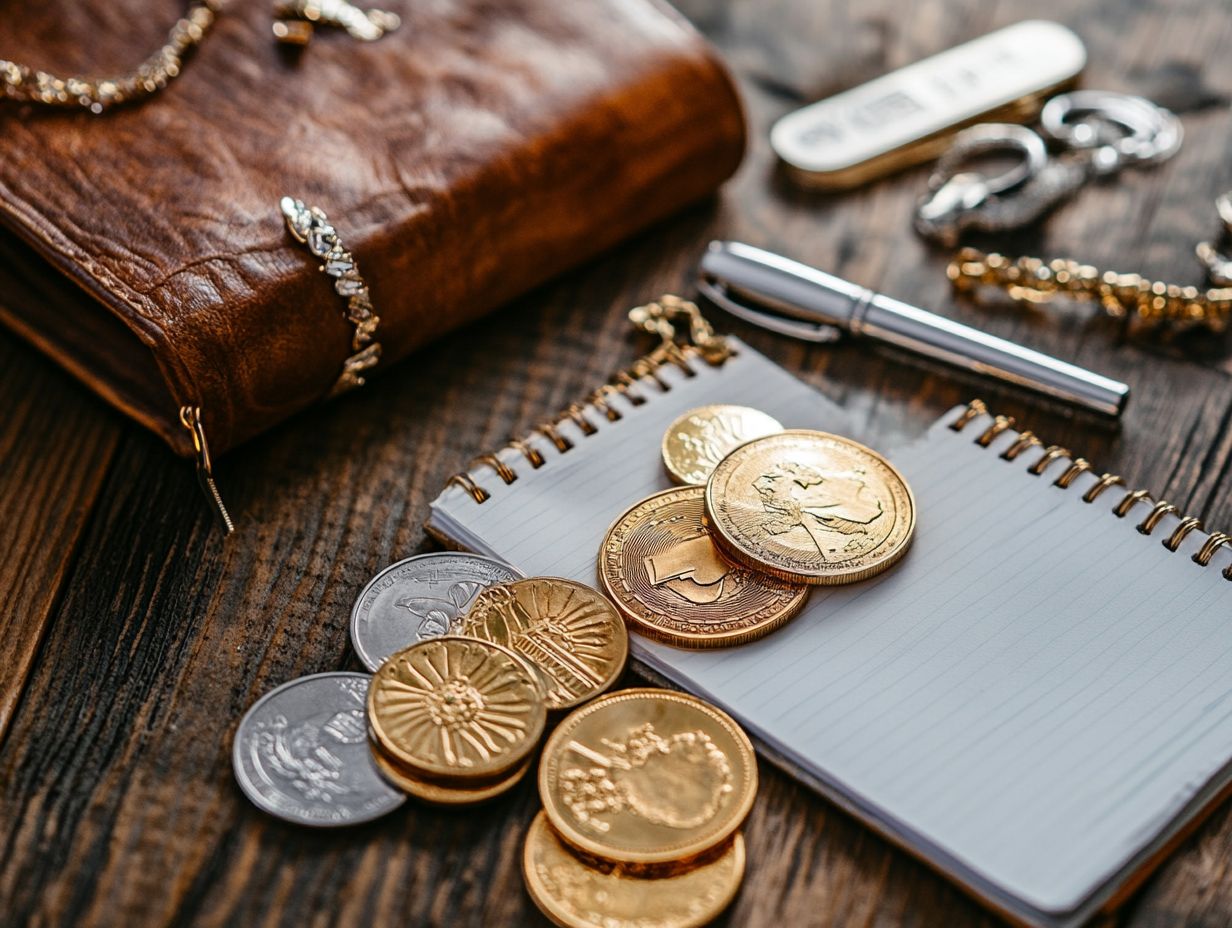
- Protect your wealth from inflation by diversifying with precious metals.
- Gold and silver aren’t just pretty; they can be smart options for your estate planning!
- Get professional advice to navigate tax implications when adding precious metals to your estate plan.
What is Estate Planning?
Estate planning is an essential process that allows you to thoughtfully strategize and document how your assets whether it s cash, precious metals, or other valuable items will be managed and distributed after you’re gone. This involves various legal documents, including wills and trusts, designed to ensure financial security for your heirs while minimizing estate and inheritance taxes.
By taking this proactive approach, you empower yourself to make informed decisions about preserving your wealth and transferring your assets, particularly in the face of economic uncertainties.
You can also incorporate joint accounts and beneficiary designations to simplify the distribution process. This will help you bypass the often tedious probate process altogether. By clearly outlining your wishes and establishing trusts, you can protect your assets from unnecessary delays and taxes, ensuring a seamless transition for your loved ones.
This meticulous planning addresses your immediate financial needs and takes into account long-term considerations, such as potential healthcare costs and retirement funds.
A well-structured estate plan can significantly alleviate the burden on your family during an emotionally challenging time, providing them with the clarity and confidence they need to execute your wishes effectively.
Reasons to Include Precious Metals in Estate Planning
Incorporating precious metals such as gold and silver into your estate planning can be a savvy strategy for wealth preservation and economic stability. These metals serve as an effective hedge against inflation and economic turbulence.
Historically, precious metals have maintained their value, establishing themselves as a reliable store of wealth. By diversifying your portfolio with these assets, you can safeguard your financial future and protect your assets over time.
Benefits of Diversification and Inflation Protection
The advantages of a diversification strategy in estate planning are numerous, especially when it comes to protecting your wealth from inflation. Tangible assets like precious metals can often outperform fiat currency during economic fluctuations.
By incorporating gold and silver into your estate plan, you not only safeguard your wealth but also enhance the resilience of your entire financial portfolio.
Historical data reveals that during inflationary periods, precious metals have held their value far better than paper currencies. Take the 1970s as an example; when inflation soared above 13%, gold prices surged, providing substantial returns for investors.
This trend remains relevant today, with many financial experts advising that you allocate at least 10-15% of your portfolio to gold and silver for optimal protection against rising costs.
Unlike stocks and bonds, precious metals aren’t tied to a single economy, offering an extra layer of security. This strategic asset allocation not only helps mitigate risks but also positions you to benefit from long-term appreciation.
Don t wait! Start incorporating precious metals into your estate plan today for a secure tomorrow.
Types of Precious Metals for Estate Planning
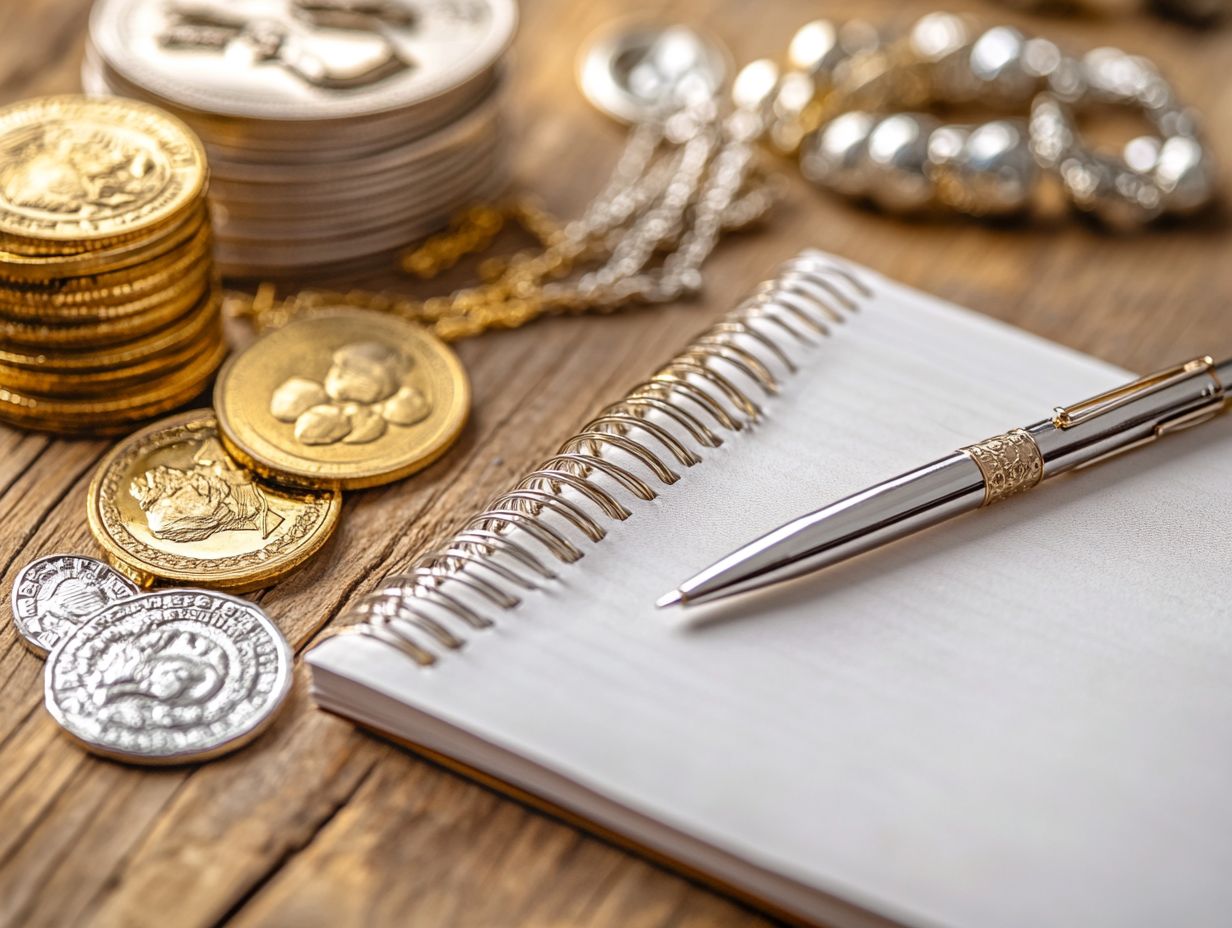
Include various precious metals to boost your estate’s value! In estate planning, gold, silver, and platinum stand out as the most sought-after choices.
These metals, along with bullion, serve as reliable stores of value. They also offer distinct advantages for preserving wealth and protecting against economic fluctuations.
Gold, Silver, Platinum, and Other Options
Gold, silver, and platinum are not just attractive options; they are valuable assets that can elevate your financial strategy. Each metal has its own market dynamics and characteristics.
This makes them suitable for various investment strategies and estate planning objectives. Gold is a safe-haven asset. It often shines during economic downturns and serves as a reliable hedge against inflation.
Silver is more volatile but has unique industrial applications that can drive demand. This potential can lead to price appreciation over time. Meanwhile, platinum offers strategic advantages due to its rarity and roles in high-demand industries like automotive and jewelry.
These metals enhance diversification and provide a buffer against market fluctuations. Their strategic importance in a comprehensive estate planning approach cannot be overstated.
How to Incorporate Precious Metals into Your Estate Plan
Incorporating precious metals into your estate plan requires a thoughtful approach. Start by selecting the right estate planning documents to clearly define how these assets will be managed and transferred.
Whether you choose trust accounts, joint accounts, or direct inheritance, ensure your wealth is safeguarded and seamlessly passed on to your heirs.
By taking these deliberate steps, you re not just planning for the future; you re preserving a legacy.
Step-by-Step Guide
Creating a step-by-step guide for incorporating precious metals into your estate plan involves several essential guidelines. These ensure effective management and financial security for your heirs.
- Begin by determining which types of precious metals you wish to include, such as gold, silver, platinum, or palladium. Each offers unique benefits and risks.
- Next, assess the current market value of these assets to gauge their worth within your estate.
- Establish clear documentation regarding ownership and distribution to streamline the process for your beneficiaries.
- Consult a financial advisor who specializes in estate planning and precious metals. This will deepen your understanding of legal requirements and tax implications.
Tax Considerations for Using Precious Metals in Estate Planning
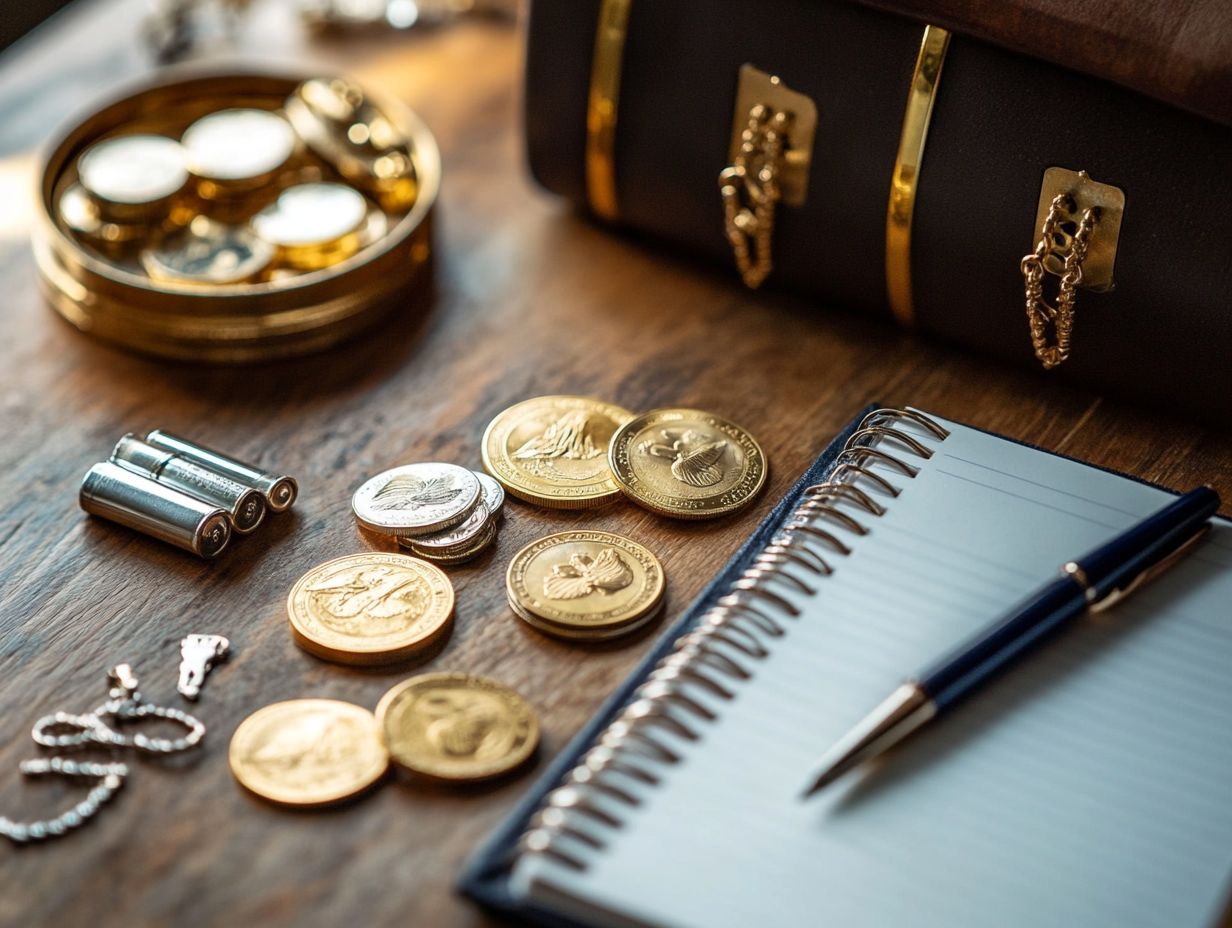
Understanding the tax implications of using precious metals in your estate planning is crucial. This can profoundly influence the financial legacy you leave behind for your heirs.
Carefully evaluate factors like estate taxes, inheritance taxes, and taxes on profits from selling your metals. This thorough review ensures compliance with IRS regulations while preserving your wealth for future generations.
Impact on Inheritance and Capital Gains Taxes
The impact of precious metals on inheritance and capital gains taxes can be substantial. These tangible assets often appreciate over time and face different tax rates than fiat currency.
By understanding how these taxes apply, you can plan more effectively for transferring valuable assets to your heirs. For instance, when you inherit gold or silver, the fair market value at the time of inheritance establishes the basis for any future capital gains calculations, potentially offering you a tax advantage.
This means that if the asset appreciates in value after you inherit it, only the gains realized after the inheritance date will be taxed. To further minimize tax liabilities, consider strategies such as:
- Gifting precious metals before death
- Utilizing tax-exempt accounts
- Establishing a trust
These strategies can effectively shield your heirs from unexpected tax burdens while preserving the value of these tangible assets.
Potential Challenges and Solutions
Navigating the challenges of planning your estate especially when incorporating precious metals can be daunting. It s crucial to identify potential hurdles and understand the relevant solutions.
Understanding these hurdles will ensure a smooth asset transfer and effective wealth preservation for your heirs.
Addressing Potential Issues and Risks
Addressing potential issues and risks in your estate planning regarding precious metals is essential for maintaining financial security. This ensures a seamless asset transfer process.
Being aware of these risks gives you the power to take steps to protect your estate from unforeseen challenges. One significant risk is the fluctuating market value of precious metals, which can impact the overall worth of your estate over time.
If ownership is not properly documented, disputes may arise among heirs. Misunderstandings about asset distribution can lead to unnecessary conflicts.
To mitigate these concerns, it s wise to keep accurate records of your holdings and consider a professional appraisal. Establishing a clear directive in your will or trust regarding the handling of precious metals can provide clarity and help prevent disputes.
This way, you can ensure that your estate s financial lineage remains intact and secure.
Frequently Asked Questions
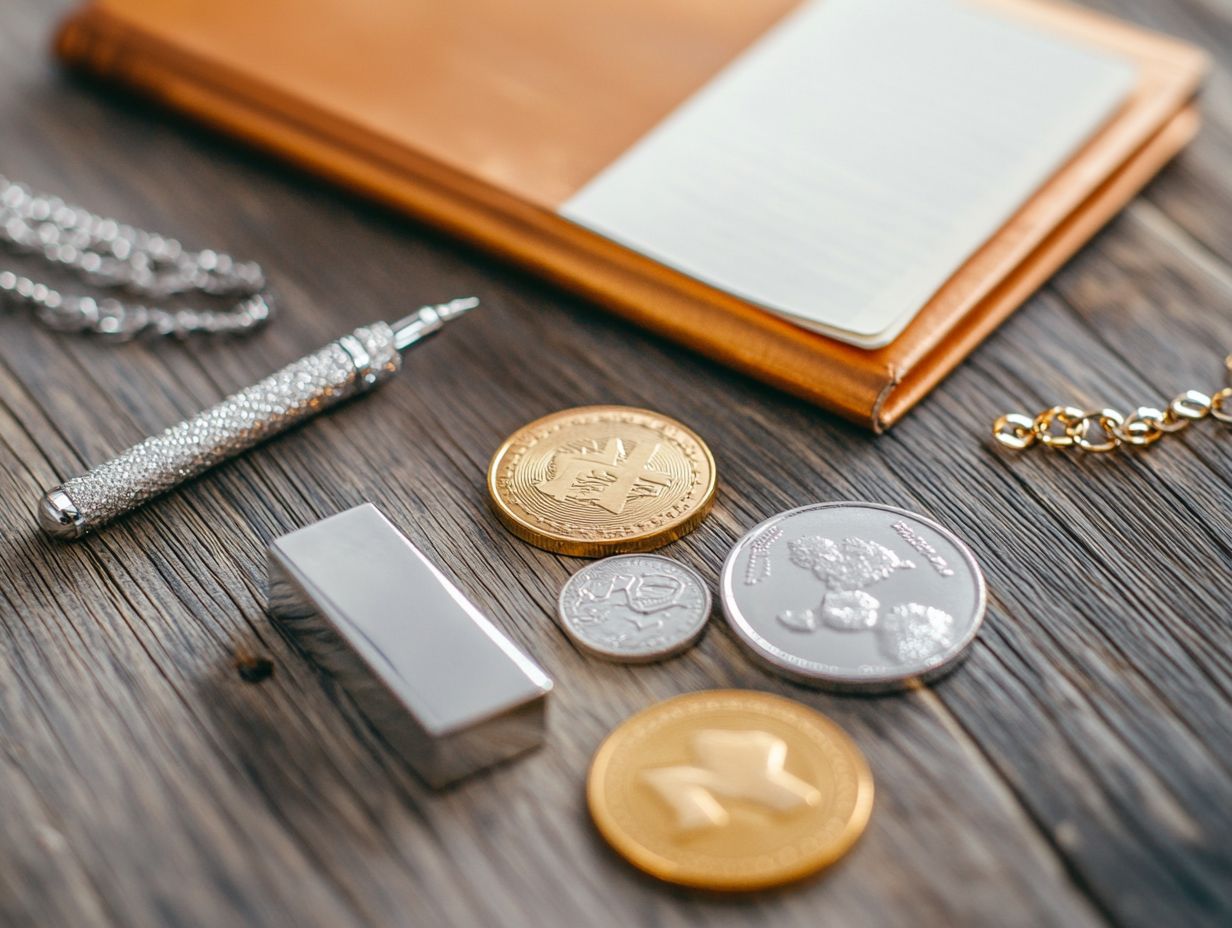
What is estate planning and how can precious metals be used in it?
Estate planning is the process of arranging for the management and distribution of one’s assets after their death. Precious metals, such as gold and silver, can be included in an estate plan as a way to preserve and pass on wealth to future generations.
Why should I consider using precious metals in my estate planning?
Precious metals can provide a hedge against inflation and economic instability. They also have the potential for long-term growth, which can benefit your beneficiaries in the future.
How can I incorporate precious metals into my estate plan?
Ways to include precious metals in an estate plan include physically owning and storing the metals, investing in a precious metals fund, or designating them as a specific bequest in your will or trust.
What are the tax implications of using precious metals in estate planning?
Precious metals are subject to capital gains tax, which is a tax on the profit from selling an asset, when sold. It’s important to consult with a tax professional to determine the best strategy for minimizing potential tax implications in your estate plan.
What are the benefits of owning physical precious metals in an estate plan?
Owning physical precious metals allows for direct control over the assets. They provide a tangible asset that can be passed down to future generations without management fees.
Are there any risks involved in using precious metals in estate planning?
As with any investment, risks are involved in owning precious metals. The value can fluctuate, and there is always the possibility of theft or loss, so it s important to carefully consider these risks when including precious metals in your estate plan.
Act now to protect your wealth. Consult a financial advisor or estate planner for personalized advice.















